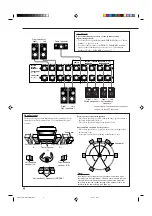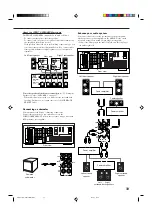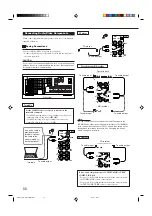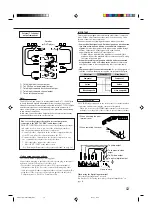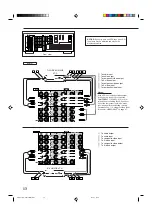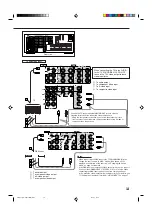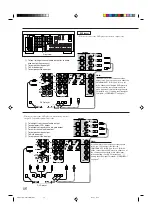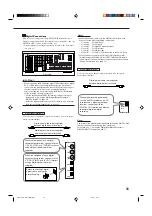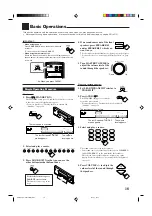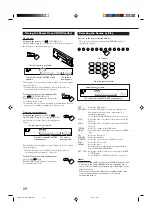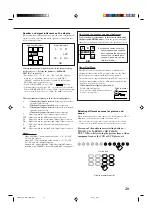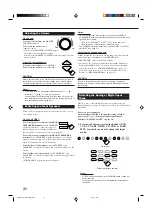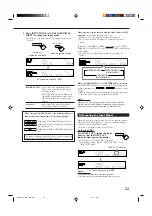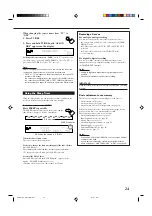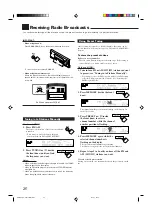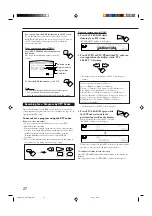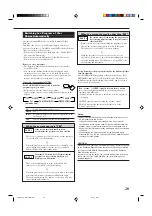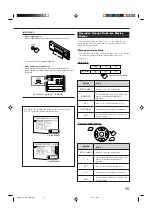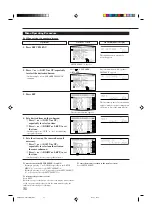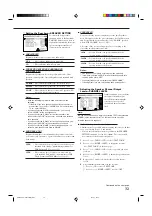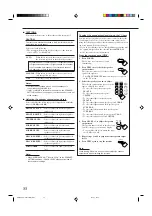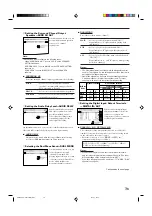
23
Muting the Sound
From the remote control ONLY:
Press MUTING to mute the sound
through all speakers and headphones
connected.
“MUTING” appears on the display and the volume
turns off (the VOLUME level indicator goes off).
To restore the sound,
press MUTING again so that “MUTING
OFF” appears on the display for a while.
• Turning MASTER VOLUME on the unit or pressing VOLUME
+/– on the remote control also restores the sound.
Turning Analog Direct On and Off
You can enjoy the sound quality closer to the original source by
skipping the sound adjustments such as Parametric Equalizer (see
page 42) and Midnight mode (see page 43). You can only adjust the
volume level while Analog Direct is in use.
• You have to make this setting for each analog source.
Press ANALOG DIRECT.
• Each time you press the button, Analog Direct turns on and off.
– When Analog Direct turns on, “ANALOG DIRECT” appears in
the main display.
Notes:
• This function is applied only to the analog sources.
• Activating one of the Surround/THX/DSP modes will cancel Analog
Direct automatically.
• If you turn on Analog Direct, the following settings are canceled
temporarily—Surround/THX/DSP modes (pages 45 and 52), Input
Attenuator (see page 22) and CC Converter, speaker output level
(page 32), Parametric Equalizer (page 42), and Midnight mode
(page 43).
Turning off Analog Direct activates the above settings except the
speaker output level settings.
• If you turn off Analog Direct while listening to an analog source,
muting time
*
will be a little longer. (
*
The period during which no
sound comes out.)
MUTING
L
ANALOG
SPEAKERS
1
SUBWFR
R
Ex. When the source is “VIDEO.”
The VOLUME level
indicator goes off.
dB
L
ANALOG
SPEAKERS
VOLUME
1
SUBWFR
R
Ex. When the source is “VIDEO.”
From the remote control
On the unit
(inside the front door)
ANALOG
DIRECT
ANALOG DIRECT
Making Sounds Natural
JVC’s CC (Compensative Compression) Converter eliminates jitter
and ripples, achieving a drastic reduction in digital distortion by
processing the digital music data in 24 bit–quantization and by
expanding the sampling frequency to 128 kHz (for fs 32 kHz
signals)/176.4 kHz (for fs 44.1 kHz signals)/192 kHz (for fs 48 kHz
signals). By using the CC Converter, you can obtain a natural sound
field from both digital and analog sources.
Press CC CONVERTER so that the CC
CONVERTER lamp lights up.
• Each time you press the button, CC Converter turns on and off (the
lamp goes off) alternately.
Notes:
• You cannot use this function while Analog Direct or THX mode is in
use. If you turn on Analog Direct or THX mode while this function is
in use, this function will be canceled temporarily.
• This function does not work for the surround back channel when
the source is “EXT 7.1CH.”
Changing the Display Brightness
You can dim the display.
Press DIMMER.
• Each time you press the button, the brightness level of the display
changes as follows:
Changing the Source Name
When you have connected an MD recorder to the TAPE/MD IN
jacks or the DBS tuner to the TV SOUND/DBS IN jacks on the rear
panel, change the source name which will be shown on the display
when you select the MD recorder or DBS tuner as the source.
On the unit ONLY:
When changing the source name from
“TAPE” to “MD”:
1. Press TAPE/MD.
2. Press and hold TAPE/MD until
“ASSGN. MD” appears on the display.
On the unit
CC CONVERTER
From the remote control
CC CONVERTER
DIMMER
DIMMER
TAPE/MD
On the unit
From the remote control
Dimmer
Much dimmer
Canceled
(Normal display)
L
ANALOG
SPEAKERS
VOLUME
1
SUBWFR
R
dB
EN18-24_RX-DP20VSL[B]f.pm5
03.5.21, 18:51
23

